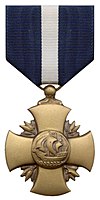Wayne Rollings
Wayne E. Rollings | |
|---|---|
Bronze Star Purple Heart (2) | |
| Other work | President, Marine Military Academy |
Early career
Rollings was born on January 11, 1941, in Orangeburg, South Carolina. He began his career in the Marines by enlisting in 1960. After completing
In 1968, Rollings graduated with a
In Vietnam, Rollings earned the Navy's second-highest honor for valor and heroism in combat, the

The President of the United States
Takes Pleasure in Presenting
The Navy Cross
To
Wayne E. Rollings
First Lieutenant, United States Marine Corps
For Services as Set Forth in the Following Citation:
The President of the United States takes pleasure in presenting the Navy Cross to Wayne E. Rollings (107099), First Lieutenant, U.S. Marine Corps, for extraordinary heroism on 18 September 1969 as a patrol leader with the First Force Reconnaissance Company, First Reconnaissance Battalion,
Marine Corps career
After returning from Vietnam in 1970, he became a rifle
In 1974, he transferred to the Middle East and served a tour of duty with the United Nations Observer Team. Upon completion of that assignment, he reported to the 2d Marine Division, Marine Corps Base Camp Lejeune, North Carolina in 1975, where he was assigned as a Rifle Company Commander, and then as the Battalion Operations and Training Officer of 1st Battalion, 6th Marines. In 1977, he was reassigned to 2nd Force Reconnaissance Company where he became the Commanding Officer.
As a major, he attended the
From 1984 to 1985, Rollings attended the
Following his selection to colonel in 1988, Rollings reported to the
Additional information
Rollings set the world record for
Awards
 | |||

| |||
Navy Marine Corps Parachutist Badge
| ||||||||||||
| 1st Row | Navy Cross
|
award star
|
Defense Superior Service Medal | |||||||||
|---|---|---|---|---|---|---|---|---|---|---|---|---|
| 2nd Row | valor device
|
award star
|
award star
|
Navy Marine Corps Commendation Medal | ||||||||
| 3rd Row | Combat Action Ribbon | Joint Meritorious Unit Award | Navy Unit Commendation | Navy Meritorious Unit Commendation
| ||||||||
| 4th Row | National Defense Service Medal w/ 1 service star | Armed Forces Expeditionary Medal | Vietnam Service Medal | Navy Sea Service Deployment Ribbon | ||||||||
| 5th Row | Vietnam Gallantry Cross Unit Citation
|
Vietnam Civil Actions Unit Citation (First Class) | United Nations Medal | Vietnam Campaign Medal | ||||||||
- Note: The gold US Navy Parachute Rigger badge was worn unofficially by USMC personnel in place of the US Army parachutist badge from 1942–1963 before it officially became the Navy and Marine Corps Parachutist insignia on July 12, 1963, per Bureau of Naval Personnel Notice 1020. Members of the Marine Corps who attended jump school before 1963 were issued the silver Army parachutist badge but may be depicted wearing the gold Navy Parachute Rigger badge as it was common practice during this time period.
Notes
- ^ "Official Biography:Major General Wayne E. Rollings". Biographies: General Officers & Senior Executives. United States Marine Corps. Retrieved 2009-12-08.
- ^ "1st Reconnaissance Battalion — Navy Cross Recipients". United States Marine Corps, 1st Reconnaissance Battalion. Retrieved 2009-12-09.
- ^ Stubbe, Ray W. AARUGHA!, 1981, pages 200-201 (republished as FMFRP 12-21 by the Marine Corps Combat Development Command on May 15, 1989).
References
- "Official Biography: Major General Wayne E. Rollings — Retired". Biographies: General Officers & Senior Executives. Manpower & Reserve Affairs, United States Marine Corps. Archived from the original on 2012-03-04. Retrieved 2009-12-09..

